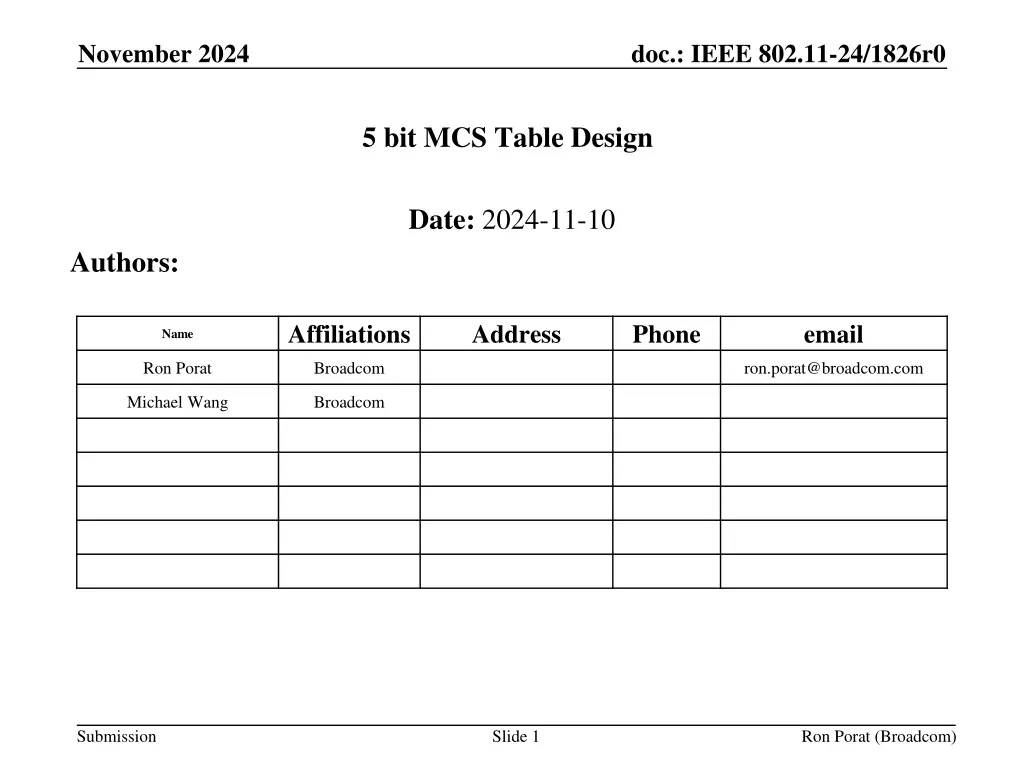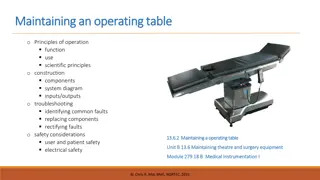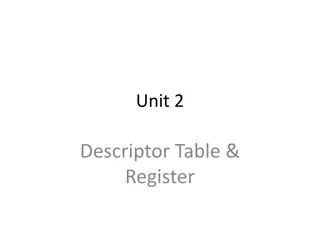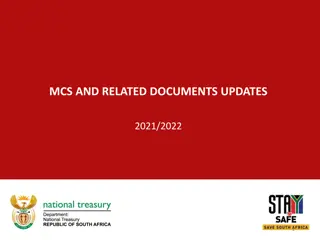
IEEE 802.11-24/1826r0: MCS Table Design Proposal
Explore the proposal for a 5-bit MCS table design in IEEE 802.11-24/1826r0, which includes the addition of 4 new MCS and their strategic placement. The suggested table layout aims for simplicity and ease of implementation while accommodating existing MCS options.
Download Presentation

Please find below an Image/Link to download the presentation.
The content on the website is provided AS IS for your information and personal use only. It may not be sold, licensed, or shared on other websites without obtaining consent from the author. If you encounter any issues during the download, it is possible that the publisher has removed the file from their server.
You are allowed to download the files provided on this website for personal or commercial use, subject to the condition that they are used lawfully. All files are the property of their respective owners.
The content on the website is provided AS IS for your information and personal use only. It may not be sold, licensed, or shared on other websites without obtaining consent from the author.
E N D
Presentation Transcript
doc.: IEEE 802.11-24/1826r0 November 2024 5 bit MCS Table Design Date: 2024-11-10 Authors: Affiliations Address Phone email Name Ron Porat Broadcom ron.porat@broadcom.com Michael Wang Broadcom Submission Slide 1 Ron Porat (Broadcom)
doc.: IEEE 802.11-24/1826r0 November 2024 Introduction The group agreed to add 4 new MCS [1]. This naturally calls for a clean design using a 5 bit MCS table to accommodate the existing 16 MCS options and the new MCS. In here we propose: The first 16 entries of the new table are identical to 11be as changing that order is highly unattractive across the industry The 4 new MCS are placed in locations that simplify implementation as unlike in previous amendments these new MCS fall in between existing MCS As shown in the next slide we propose to define the location of the new MCS such that the (new MCS entry 16) forms a monotonically increasing rate table easy to understand and use Submission Slide 2 Ron Porat (Broadcom)
doc.: IEEE 802.11-24/1826r0 November 2024 Proposed Locations of new MCS New rates in blue: MCS[4] =1 (MSB) yields a rate right above the rate when MCS[4]=0 for the same MCS[3:0] MCS (effectively) 0 1 17 (17-16 1.5) 2 3 19 (19-16 3.5) 4 20 (20-16 4.5) 5 6 7 23 (23-16 7.5) 8 9 10 MCS[4] 0 0 1 0 0 1 0 1 0 0 0 1 0 0 0 MCS[3:0] 0 1 1 2 3 3 4 4 5 6 7 7 8 9 10 Modulation BPSK QPSK QPSK QPSK 16 16 16 16 64 64 64 256 256 256 1K Code rate 1/2 1/2 2/3 3/4 1/2 2/3 3/4 5/6 2/3 3/4 5/6 2/3 3/4 5/6 3/4 bps/Hz 0.5 1 1.33 1.5 2 2.67 3 3.33 4 4.5 5 5.33 6 6.67 7.5 Submission Slide 3 Ron Porat (Broadcom)
doc.: IEEE 802.11-24/1826r0 November 2024 Summary We proposed a 5 bit MCS table design: The first 16 entries of the new table are identical to 11be Locations for the 4 new MCS Submission Slide 4 Ron Porat (Broadcom)
doc.: IEEE 802.11-24/1826r0 November 2024 References [1] 11-24-1186-01-00bn-new-mcss-for-11bn-follow-up, Shengquan Hu (Mediatek) Submission Slide 5 Ron Porat (Broadcom)
doc.: IEEE 802.11-24/1826r0 November 2024 SP#1 Do you agree to add to the 11bn SFD? A 5 bit MCS table is used to indicate all UHR MCSs. Submission Slide 6 Ron Porat (Broadcom)
doc.: IEEE 802.11-24/1826r0 November 2024 SP#2 Do you agree to add to the 11bn SFD? The first 16 entries of the 5 bit MCS table (MCS0 to MCS15) are identical to 11be Submission Slide 7 Ron Porat (Broadcom)
doc.: IEEE 802.11-24/1826r0 November 2024 SP#3 Do you agree to add to the 11bn SFD? In the 5bit MCS table MCS17 signals QPSK rate 2/3 MCS19 signals 16QAM rate 2/3 MCS20 signals 16QAM rate 5/6 MCS23 signals 256QAM rate 2/3 Submission Slide 8 Ron Porat (Broadcom)







